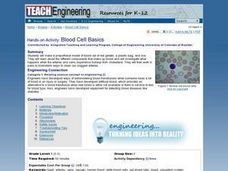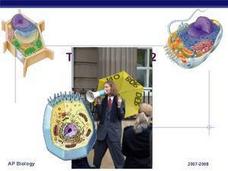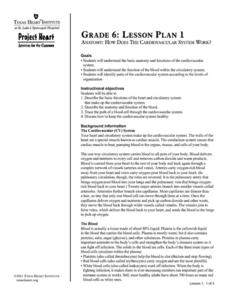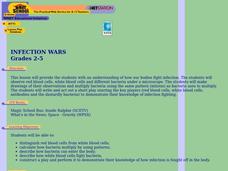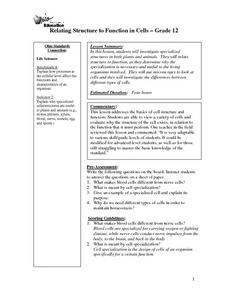Curated OER
Blood Cell Basics
Students design a proportional model of blood out of red gelatin, a plastic bag, and rice. They study the components that make up blood and investigate what happens when the arteries in different scenerios. They work in pairs in order to...
Curated OER
Making Blood
Fifth graders review the components of blood and write four things they have learned. They view a videodisk related to blood components and create a batch of candy "blood" using terminology including platelets, red blood cells, white...
Howard Hughes Medical Institute
Cells of the Immune System
You won't be able to resist the content of a great presentation! Young immunologists discover the variety of cells involved in keeping our bodies free from pathogens with a resource that contains both slides and video clips. The included...
Curated OER
The Journey of a Red Blood Cell
Fifth graders examine how a red blood cell travels throughout the body. Using a model, they recreate the flow of blood through the heart. They also label the lungs and the differece between the blood that enters the heart and the blood...
Curated OER
Counting Blood Cells
Students observe number sense by participating in an estimation activity. In this blood cells lesson plan, students identify the importance of blood cells in the human body and discuss how tiny they are. Students utilize paper dots as a...
Curated OER
Tour of the Cell 2
As your class views each slide, they will be introduced to the organelles and structure of the cell. Details about structure and function are given and also some trivia about their frequency and population. There is also some...
Curated OER
Were the babies switched? – The Genetics of Blood Types
Human biology or genetics learners apply their knowledge to a unique situation: two newborn baby girls being possibly switched in the hospital. The engaging activity ends with a Punnett squares assignment in which pupils...
Curated OER
Red Gold-The Epic Story of Blood
In this blood worksheet, students watch a video called "The Epic Story of Blood" and answer 24 questions about the creation of blood, how it is produced, blood donation, blood banks and transfusions. Students take an short quiz about the...
Texas Heart Institute
Anatomy: How Does the Cardiovascular System Work?
How can the circulatory system compare to a city map? Pupils distinguish the "roadways" and "vehicles" of the cardiovascular system, compare the anatomy and function of veins and arteries, and review different types of blood cells with...
Scholastic
Study Jams! The Immune System
A set of slides depicts sick children, an artistic rendition of a white blood cell amongst red blood cells, and a diagram of part of the lymph system to teach youngsters about immunity. Kids will find that it is made up of skin, white...
Curated OER
Making Blood!
students research blood's components, and use their math skills to recreate a model of whole blood using commonly found food items.
Curated OER
Making Blood!
Ninth graders study facts about human blood and what it is made of. In this blood composition lesson plan students divide into groups and complete several activities.
Curated OER
Regents High School Examination: Living Environment 2003
The living environment, from the interior of a cell to the complex relationships among populations, are queried in this final examination. Learners look at air pollution maps, diagrams of cells, population graphs, and drawing of cells....
Curated OER
Regents High School Exam: Living Environment 2008
Tne New York Regents High School Examinations are comprehensive and include various styles of questions, includingmultiple choice and the analysis of graphs. This particular version, the 2008 Living Environment exam surveys a variety of...
Curated OER
Regents High School Examination: Living Environment 2005
The 2005 version of the Regents High School Examination in the area of ecology is as comprehensive as previous years' exams. It consists of 40 multiple choice questions on everything from the structure of DNA to the interactions within...
Curated OER
Infection Wars
Students explore how our bodies fight infection. Using a microscope, they observe red blood cells, white blood cells and different bacteria under a microscope.
Curated OER
Body Battles!
Seventh graders explain the role of white blood cells in fighting infections. In this life science lesson, 7th graders create flow charts showing the immune response process. They act out and play a game to simulate actions of the immune...
Curated OER
The Journey of a Red Blood Cell
Fifth graders examine how a red blood cell travels throughout the body. Using a model, they follow the flow of blood throughout the entire body. They identify the functions of the lungs and discuss the difference of the blood entering...
Curated OER
T Cells Fight The Flu!
Students examine T cells and the role they play in the immune system. In this interactive instructional activity students work in groups to complete an online training and make a comic strip with what they learned.
Biology Junction
Cellular Structure
The human body contains more than 200 types of cells, and plants contain many other unique types of cells. While a huge variety of cells exist, they appear to have very similar structures. A detailed presentation describes the structure...
Curated OER
Blood
In this blood worksheet, students describe the four functions of blood. Then they write what each part of the human body illustrated does below the picture. Students also complete the table on possible blood types of a receiver and donor...
Curated OER
Relating Structure to Function in Cells
Twelfth graders investigate specialized structures in both plants and animals. They relate structure to function, as they determine why the specialization is necessary and useful to the living organisms involved. They use microscopes...
Ask A Biologist
Viral Attack
Can you catch the same cold twice? Elementary and middle schoolers learn about what happens when a virus attacks their bodies, and how the immune system never forgets a virus, with an entertaining comic book. The packet includes...
Howard Hughes Medical Institute
The Making of the Fittest: The Birth and Death of Genes
Adaptations must be made as environments change. This fabulous presentation features Icelandic icefish, a transparent, scaleless specimen that even has colorless blood. Genetics and adaptations concepts are explored as scientists study...


